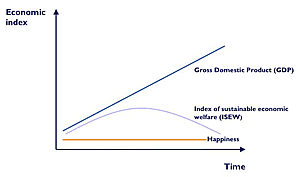I was exposed to the ISEW by Josephine Green of Philips at the ID Design Strategy conference. She struck me as the female John Thakara: highly intelligent and morally scolding, and dropping in your lap the challenge of solving the problems she just convinced you are vitally important.
To understand how ISEW differs from, say, measuring GDP, first look at them graphed together:

Then read the description:
The ISEW is one of the most advanced attempts to create an indicator of economic welfare. It is an attempt to measure the portion of economic activity which delivers genuine increases in our quality of life – in one sense ‘quality’ economic activity. For example, it makes a subtraction for air pollution caused by economic activity, and makes an addition to count unpaid household labour — such as cleaning or child-minding. It also covers areas such as income inequality, other environmental damage, and depletion of environmental assets.
And hear how the proponents respond to criticism:
Some commentators say that the use of such ‘non-statistical’ judgements invalidates the utility of ISEW. However, this is even more of a problem for GDP when it is used as an indicator of progress — for its own value judgement is that these adjustments be set at zero.
In the past you might have gotten traction with a name like ISEW, but I’d like to see it reframed — possibly with the help of the Longview Institute — into an idea progressive political candidates can run on. For now, we can all start chipping away at the use of GDP.